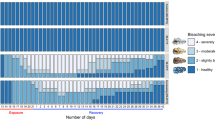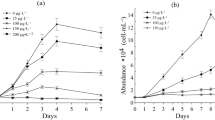Abstract
To evaluate the photoinhibition of colonial and unicellular cells of Microcystis aeruginosa under natural conditions, the maximum and effective quantum yields of photosystem II were measured from variable chlorophyll a fluorescence in samples from Lake Taihu during a summer bloom from June 19 to 21, 2006. Diurnal changes in the photoinhibition of Microcystis cells incubated immediately below the surface in clear bottles for 30 min and in situ samples under natural conditions were measured. At solar noon during the three days, the mean values of maximum quantum yield (F v/F m) and effective quantum yield (ΔF/F m′) for unicellular cells (F v/F m = 0.15, ΔF/F m′ = 0.10) were lower than those for colonial cells (F v/F m = 0.25, ΔF/F m′ = 0.15). For in situ samples, the values of F v/F m and ΔF/F m′ for colonial cells at solar noon on the three days (F v/F m 0.30, 0.25, 0.29; ΔF/F m′ 0.24, 0.21, 0.22) were also higher than those of unicellular cells (F v/F m 0.26, 0.18, 0.25; ΔF/F m′ 0.15, 0.11, 0.14). The results indicate that colony formation has a protective effect on Microcystis cells by reducing the occurrence of photoinhibition under high light intensities.




Similar content being viewed by others
References
Abeliovich A, Shilo M (1972) Photooxidative death in blue-green algae. J Bacteriol 111:682–689
Agust S, Phlips EJ (1992) Light absorption by cyanobacteria: implications of colonial growth form. Limnol Oceanogr 37:434–441
Anishchenko OV, Kolmakov VI, Gladyshev MI (2004) Effect of meteorological factors on the fluorescence parameters of a blooming body of water. Dokl Biol Sci 397:301–304
Baker NR, Bowyer JR (1994) Photoinhibition of photosynthesis: from molecular mechanisms to the field. Bios Scientific, Oxford
Ballot A, Krienitz L, Kotut K, Wiegand C, Metalf JS, Codd GA, Pflugmacher S (2004) Cyanobacteria and cyanobacterial toxins in three alkaline Rift Valley lakes of Kenya—Lakes Bogoria, Nakuru and Elmenteita. J Plankt Res 26:925–935
Brookes JD, Ganf GG, Oliver RL (2000) Heterogeneity of cyanobacterial gas-vesicle volume and metabolic activity. J Plankton Res 32:1399–1411
Brookes JD, Regel RH, Ganf GG (2003) Changes in the photo-chemistry of Microcystis aeruginosa in response to light and mixing. New Phytol 158:151–164
Canter HM, Walsby AE, Kinsman R, Ibelings BW (1992) The effect of attached vorticellids on the buoyancy of the colonial cyanobacterium Anabaena lemmermannii. Eur J Phycol 27:65–74
Chen J, Xie P (2005) Seasonal dynamics of the hepatotoxic microcystins in various organs of four freshwater bivalves from the large eutrophic Lake Taihu of the subtropical China and the risk to human consumption. Environ Toxicol 20:572–584
Chen Y, Qin B, Teubner K, Dokulil M (2003) Long-term dynamics of phytoplankton assemblages: Microcystis-domination in Lake Taihu, a large shallow lake in China. J Plankton Res 25:445–453
Chen J, Zhang DW, Xie P, Wang Q, Ma ZM (2009a) Simultaneous determination of microcystin contaminations in various vertebrates (fish, turtle, duck and water bird) from a large eutrophic Chinese lake, Lake Taihu, with toxic Microcystis blooms. Sci Total Environ 407:3317–3322
Chen J, Xie P, Li L, Xu J (2009b) First identification of the hepatotoxic microcystins in the serum of a chronically exposed human population together with indication of hepatocellular damage. Toxicol Sci 108:81–89
Eloff JN, Steinitz Y, Shilo M (1976) Photooxidation of cyanobacteria in natural conditions. Appl Environ Microb 31:119–126
Gao KS, Ai HX (2004) Relationship of the growth and photosynthesis with colony size in an edible cyanobacterium, Ge-Xian-Mi Nostoc (Cyanophyceae). J Phycol 40:523–526
Hader DP, Figueroa FL (1997) Photoecophysiology of marine macroalgae. Photochem Photobiol 66:1–14
Hader DP, Porst M, Lebert M (2000) On site photosynthetic performance of Atlantic green algae. J Photochem Photobiol B Biol 57:159–168
Hanelt DP (1996) Photoinhibition of photosynthesis in marine macroalgae. Sci Mar 60:243–248
Hanelt DP, Hupperts K, Nultsch W (1992) Photoinhibition of photosynthesis and its recovery in red algae. Bot Acta 105:278–284
Hortonn P, Ruban A (2005) Molecular design of the photosystem II light-harvesting antenna: photosynthesis and photoprotection. J Exp Bot 56:365–373
Humphries SE, Lyne VD (1988) Cyanophyte blooms: the role of cell buoyancy. Limnol Oceanogr 33:79–91
Ibelings SW, de Winder B (1994) The effect of irradiance, temperature and desiccation on cyanobacterial photosynthesis: a possible explanation for diurnal variation in surface water blooms. In: Stal LS, Caumette P (eds) Microbial mats. Springer, Berlin, pp 311–318
Ibelings BW, Maberly SC (1998) Photoinhibition and the availability of inorganic carbon restrict photosynthesis by surface blooms of cyanobacteria. Limnol Oceanogr 43:408–419
Ibelings BW, Mur LR (1992) Microprofiles of photosynthesis and oxygen concentration in Microcystis sp. scums. FEMS Microbiol Ecol 86:195–203
Jarvis AJ, Robert CH, Combrink S (1987) Zooplankton feeding on size fractionated Microcystis colonies and Chlorella in a hypertrophic lake (Hartbeespoort Dam, South Africa): implications to resource utilization and zooplankton succession. J Plankton Res 9:1231–1249
Jones RJ, Hoegh-Guildberg O (2001) Diurnal changes in the photochemical efficiency of the symbiotic dinoflagellates (Dinophyceae) of corals: photoprotection, photoinactivation and the relationship to coral bleaching. Plant Cell Environ 24:89–99
Kirilovsky D (2007) Photoprotection in cyanobacteria: the orange carotenoid protein (OCP)-related non-photochemical-quenching mechanism. Photosynth Res 93:7–16
Kong FX, Ma RH, Gao JF, Wu XD (2009) The theory and practice of prevention, forecast and warning on cyanobacterial bloom in Lake Taihu. J Lake Sci 21:314–328
Krause GH, Weis E (1991) Chlorophyll fluorescence and photosynthesis: the basics. Annu Rev Plant Physiol Plant Mol Biol 42:213–249
Li Y, Gao K (2004) Photosynthetic physiology and growth as a function of colony size in the cyanobacterium Nostoc sphaeroides. Eur J Phycol 39:9–15
Liu YQ, Xie P, Zhang DW, Wen ZR (2008) Seasonal dynamics of Microcystins with associated biotic and abiotic parameters in two Bays of Lake Taihu, the third largest freshwater lake in China. Bull Environ Contam Toxicol 80:24–29
Long BM, Jones GJ, Orr PT (2001) Cellular microcystin content in N-limited Microcystis aeruginosa can be predicted from growth rate. Appl Environ Microb 67:278–283
Ma RH, Kong FX, Duan HT, Zhang SX, Kong WJ, Hao JY (2008) Spatio-temporal distribution of cyanobacteria blooms based on satellite imageries in Lake Taihu, China. J Lake Sci 20:687–694 (in Chinese with English abstract)
O’Brien KR, Meyer DL, Waite AM, Ivey GN, Hamilton DP (2004) Disaggregation of Microcystis aeruginosa colonies under turbulent mixing: laboratory experiments in a grid-stirred tank. Hydrobiologia 519:143–152
Paerl HW, Bland PT, Bowles ND, Haibach ME (1985) Adaptation to high-intensity, low wavelength light among surface blooms of the cyanobacterium Microcystis aeruginosa. Appl Environ Microb 49:1046–1052
Reynolds CS (1973) Growth and buoyancy of Microcystis aeruginosa Kutz Emend. Elenkin in a shallow eutrophic lake. Proc R Soc Lond Ser B 184:29–50
Schreiber U, Neubauer C (1990) O2 dependent electron flow, membrane energization and mechanism of non-photochemical quenching of chlorophyll fluorescence. Photosynth Res 25:279–293
Schreiber U, Schliwa U, Bilger W (1986) Continuous recording of photochemical and non-photochemical chlorophyll fluorescence quenching with a new type of modulation fluorometer. Photosynth Res 10:51–62
Schreiber U, Bilger W, Neubauer C (1994) Chlorophyll fluorescence as a nonintrusive indicator for rapid assessment of in vivo photosynthesis. In: Schulze E, Caldwell M (eds) Ecophysiology of photosynthesis. Springer, Berlin, pp 49–70
Schreiber U, Endo T, Mi H, Asada K (1995) Quenching analysis of chlorophyll fluorescence by the saturation pulse method: particular aspects relating to the study of eukaryotic algae and cyanobacteria. Plant Cell Physiol 36:873–882
Schroeter B (1994) In situ photosynthetic differentiation of the green algal and the cyanobacterial photobiont in the crustose lichen Placopsis contortuplicata. Oecologia 98:212–220
Shen PP, Shi Q, Hua ZC, Kong FX, Wang ZG, Zhuang SX, Chen DC (2003) Analysis of microcystins in cyanobacteria blooms and surface water samples from Meiliang Bay, Taihu Lake, China. Environ Int 29:641–647
Thiele A, Schirwitz K, Winter K, Krause GH (1996) Increased xanthophylls cycle activity and reduced D1 protein inactivation related to photoinhibition in two plant systems acclimated to excess light. Plant Sci 115:237–250
Ueno Y, Nagata S, Tsutsumi T, Hasegawa A, Watanabe MF, Park HD, Chen GC, Chen G, Yu SG (1996) Detection of microcystins, a blue-green algal hepatotoxin, in drinking water sampled in Haimen and Fusui, endemic areas of primary liver cancer in China, by highly sensitive immunoassay. Carcinogenesis 17:1317–1321
Vassiliev IR, Prasil O, Wyman KD, Kolber Z, Hanson AK Jr, Prentice JE, Falkowski PG (1994) Inhibition of PS II photochemistry by PAR and UV radiation in natural phytoplankton communities. Photosynth Res 42:51–64
Vonshak A, Trozillo G, Tomaseli L (1994) Use of chlorophyll fluorescence to estimate the effect of photoinhibition in outdoor cultures of Sprirulina platensis. J Appl Phycol 6:31–34
Wallace BB, Bailey M, Hamilton D (2000) Simulation of vertical position of buoyancy regulating Microcystis aeruginosa in a shallow eutrophic lake. Aquat Sci 62:320–333
Xie P (2008) Development of cyanobacterial bloom in Lake Taihu and its hazards. Science, Beijing, pp 1–35 (in Chinese)
Yang Z, Kong FX, Shi XL, Zhang M, Xing P, Cao HS (2008) Changes in the morphology and polysaccharide content of Microcystis aeruginosa (cyanobacteria) during flagellate grazing. J Phycol 44:716–720
Zhang M, Kong FX, Wu XD, Xing P (2008) Different photochemical responses of phytoplankters from the large shallow Lake Taihu of subtropical China in relation to light and mixing. Hydrobiologia 603:267–278
Acknowledgments
The authors gratefully acknowledge two referees for their comments and for correcting the English of the paper. This work was financially supported by the Natural Science Foundation of China (40901268, 40671068) and the National Key Technology R&D Program (2007BAC26B01).
Author information
Authors and Affiliations
Corresponding author
Rights and permissions
About this article
Cite this article
Wu, X., Kong, F. & Zhang, M. Photoinhibition of colonial and unicellular Microcystis cells in a summer bloom in Lake Taihu. Limnology 12, 55–61 (2011). https://doi.org/10.1007/s10201-010-0321-5
Received:
Accepted:
Published:
Issue Date:
DOI: https://doi.org/10.1007/s10201-010-0321-5




